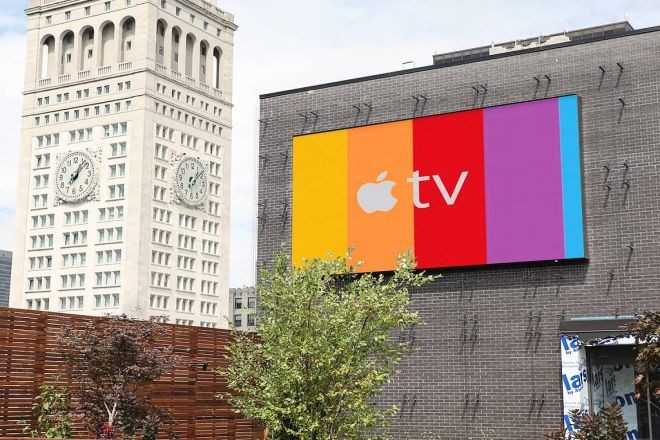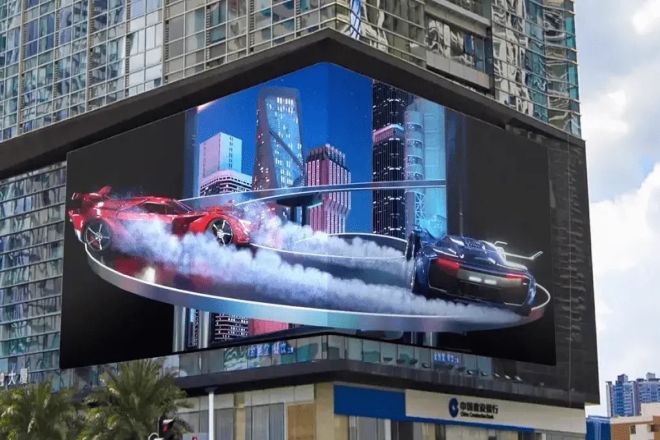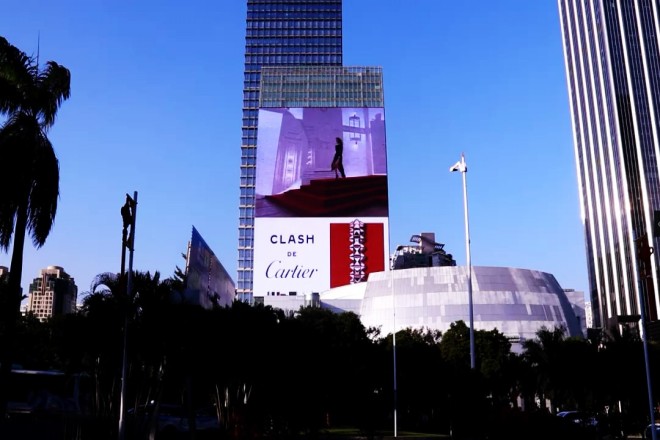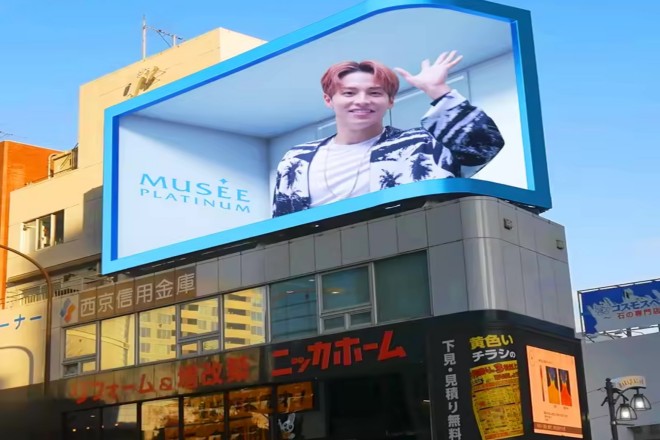Introducción

pantallas de visualización LED not only beautify urban buildings, but also become the new favorite of information dissemination. However, to ensure its safety and effect on buildings, several core elements need to be considered. This article will briefly introduce these key points.
1. Evaluation of the installation site and structural support of LED display screens

1). Site evaluation
- Dimension evaluation
You need to use high-precision measurement tools (such as laser rangefinders, total stations, etc.) to accurately measure the length, width, and height of the installation site to ensure that it fully matches the specifications of the LED display screen.
This step must be accurate. If errors are made, the final customized LED display screen will not be suitable for the on-site size, and the installation will be ugly.
Based on the measurement results, draw a detailed layout diagram, including the location of the display screen, installation frame, maintenance channel, audience viewing area, etc., to ensure that the overall layout is reasonable and meets the use requirements.
- Bearing capacity evaluation
Check the site structure drawings, geological survey reports, and other relevant materials to understand the site’s bearing capacity, foundation bearing capacity, and other key information.
You need to perform detailed load calculations based on the weight of the LED display (including the display itself, installation frame, connecting cables, heat dissipation equipment, etc.) and possible additional loads (such as the weight of personnel and equipment during maintenance).
At the same time, consider the impact of dynamic loads (such as wind loads, seismic forces, etc.) on the structure. Add the calculated total load to the safety margin and compare it with the bearing capacity of the site to ensure that it is within the safe range.
2). Structural support assessment
- Stability assessment
Since it is installed on the facade of the building, there may be a falling accident if you are not careful, so you must conduct a detailed inspection of the supporting structure, including welding points, bolt connections, and the integrity of supporting components to ensure that the structure is stable and defect-free.
Professional vibration testing equipment and structural analysis software are used to perform vibration testing and stability analysis on the supporting structure to evaluate its stability and safety under external forces such as wind loads and earthquakes.
- Wind load assessment
Check local meteorological data to understand possible parameters such as wind speed, wind direction, wind pressure, and wind load conditions under extreme weather conditions. This is also very important. All building designs have wind load assessments and predictions, and the LED display screen installed in the building is no exception.
You need to use the principles and methods of wind engineering to calculate the wind pressure on the display screen based on meteorological data and the size, shape, and other parameters of the display screen.
Then, based on the wind pressure calculation results, the support structure is reinforced by adding support components, using stronger materials, optimizing the structural layout, etc., to ensure that the support structure can withstand the wind load.
2. Evaluation of the environmental adaptability of the purchased LED display screen
1). Waterproof and dustproof treatment
LED displays, especially those used outdoors, often face challenges from environmental factors such as rain and dust. Waterproof and dustproof treatment can not only protect the electronic components inside the display screen from damage but also extend the service life of the display screen.
1.1). Evaluation points:
Nivel de impermeabilidad: Evaluate the waterproof ability of the display screen according to the IP (Ingress Protection) protection level standard. Outdoor displays are usually required to reach IP65 or higher waterproof levels to ensure that they can still work normally in severe weather such as heavy rain.
Dustproof design: Also evaluate the dustproof ability of the display screen according to the IP protection level standard. The higher the dustproof level, the less likely it is for dust to accumulate inside the display, thereby reducing the risk of failure caused by dust.
Installation measures: During the installation process, additional waterproof and dustproof measures should be taken, such as using waterproof seals, dustproof nets, etc., to ensure the sealing between the display and the external environment.
1.2). Recommendations:
Before purchasing, learn in detail about the waterproof and dustproof level and specific design of the display to ensure that it meets the requirements of the use environment.
During the installation process, strictly follow the manufacturer’s guidelines to ensure that all waterproof and dustproof measures are properly implemented.
The power supply is the basis for the stable operation of LED display screens. An unstable power supply may cause the display screen to flicker, cause a black screen, or even cause damage.
This is especially important for LED display screens installed on the facade of the building. Once the power supply is insufficient or there is a problem, maintenance is also very troublesome.
2.1). Evaluation points:
Power consumption requirements: Understand the power consumption requirements of the display screen, including maximum power, average power, etc., to ensure that the power supply can meet the operation requirements of the display screen.
Power connection: Have a professional electrician perform the power connection to ensure that the connection is firm and safe. At the same time, consider using appropriate cables and sockets to reduce power loss and safety hazards.
- Fuente de alimentación de respaldo: For outdoor or critical area displays, consider equipping with a backup power supply (such as UPS or generator) to cope with sudden power outages.
2.2). Recommendation:
Before purchasing, communicate with the manufacturer to understand the power requirements of the display, and consult professional electricians to ensure that the power supply plan is reasonable and feasible.
Check the power connection and cable status regularly to promptly detect and deal with potential safety hazards.
For displays equipped with backup power supply, regular maintenance and testing should be carried out to ensure that the backup power supply can work properly when needed.
3. Types and selection of high-rise LED display screens

1). Types of LED display screens
These large LED display screens are designed for outdoor environments and have extremely high brightness, ensuring that they are still clearly visible on sunny days.
They are usually composed of multiple LED single lamps, each of which is like a small glowing gem encapsulated in a spotlight cup to increase brightness.
These large screens are usually composed of multiple pixel units to form a dot matrix display effect. They are designed with protection characteristics to ensure stable operation in outdoor environments.
- LED grille screen (transparent CONDUJO screen):
This display is like a piece of transparent glass, but it can display various images and texts.
It has high transparency and will not block the view, so it is very suitable for installation on the exterior wall of high-rise buildings.
Unlike other transparent LED displays, grille LED displays are most suitable for outdoor installation because they have protective properties that other transparent screens do not have.
In addition, the installation methods of LED grille screens are flexible and diverse and can be customized according to the characteristics and needs of the building.
2). Choice of installation method
When we want to install LED displays on the exterior walls of high-rise buildings, we need to consider a variety of installation methods to ensure that the display is both stable and beautiful.
- Wall-mounted installation:
Although wall-mounted installation is simple and direct when used on the exterior walls of high-rise buildings, special attention should be paid to environmental factors such as the wall’s load-bearing capacity and wind pressure. If the wall is not strong enough or the wind pressure is too high, the display may fall off or be damaged.
- Hoisting installation:
For large and heavy displays, hoisting installation is a good choice. It can hang the display steadily in the air through a hoisting mechanism. But it should be noted that the hoisting mechanism must be very stable to ensure that the display will not shake when the wind is strong.
- Embedded installation:
Embedded installation is to embed the display screen completely into the wall so that it blends into the wall. This method can make the display screen look neater and more beautiful.
However, it should be noted that embedded installation has high requirements on the load-bearing capacity and construction accuracy of the wall, and it is necessary to ensure that the size of the display screen matches the hole in the wall completely.
- Customized installation:
In addition to the above common installation methods, customized installation design can also be carried out according to the actual situation of the high-rise building.
For example, the shape and size of the display screen can be designed according to the outline and shape of the building, or the most suitable installation method can be selected according to the characteristics of the building.
When choosing the installation method, we also need to consider the maintenance needs of the display screen. Because once the display screen on the exterior wall of the high-rise building is installed, it is difficult to perform frequent maintenance.
Therefore, when choosing the installation method, it is necessary to ensure that the maintenance of the display screen is convenient and quick so that it can be repaired and replaced in time when needed.
4. Things worth noting during installation
When installing LED display screens in high-rise buildings, it is indeed necessary to pay attention to multiple aspects to ensure that the installation process is smooth and the display screen runs stably, safely, and reliably.
The following is a detailed explanation of the things worth noting during installation:
1). Things worth noting during installation
1.1). Safety first
- Comply with safety regulations: During the installation process, always comply with national and local safety production regulations to ensure the personal safety of construction workers.
Personal protection: Construction workers should wear appropriate personal protective equipment, such as safety helmets, safety belts, protective glasses, gloves, etc., to prevent accidental injuries.
Site safety: Set up safety warning signs to ensure the safe isolation of the construction site and prevent non-construction personnel from entering the dangerous area.
Seguridad eléctrica: When connecting the power supply and control signal, make sure that the power is turned off and follow the electrical safety operating procedures to prevent electric shock accidents.
1.2). Quality assurance
Follow the design requirements: Strictly follow the design drawings and specifications to ensure that the installation position, size, weight, etc. of the display meet the design requirements.
Material quality: Use qualified installation materials, LED modules, power supplies, control cards and other components to ensure the stability and reliability of the display.
Installation process: Follow the correct installation process and steps to ensure the quality of the assembly, fixation, connection, and display links.
Acceptance standards: After the installation is completed, acceptance is carried out in accordance with relevant standards to ensure that the display effect, stability, safety, and other aspects of the display meet the requirements.
2). Mantenimiento y cuidado
Establish a system:Establish a regular maintenance and care system, clarify the time, content, and responsible person for maintenance and care, and ensure the normal operation of the display screen.
Inspección regular: Regularly inspect the display screen, including the connection of power cords, signal cords, Módulos LED, control cards, and other components, as well as the display effect and stability of the display screen.
Limpieza y mantenimiento:Regularly clean the display screen to remove dust, dirt, etc., and maintain the clarity and brightness of the display screen.
Reparación y reemplazo:When the display screen is found to be faulty or damaged, repair or replace it in time to ensure the normal operation of the display screen.
In summary, when installing LED display screens in high-rise buildings, special attention should be paid to safety, quality, and maintenance.
By complying with relevant regulations and operating procedures, using qualified materials and components, following the correct installation process and steps, and establishing a regular maintenance and care system, the installation quality and operation stability of the display screen can be ensured, and its service life can be extended.
5. Special design requirements for high-rise LED display screens

Installing LED display screens on high-rise buildings requires a series of special design requirements to ensure the adaptability, safety, and aesthetics of the display screen. The following is an optimized explanation of these special design requirements:
1). Adapt to the architectural background and environment
- Integrate into the architectural style:
The design of the LED display screen should be coordinated with the overall style and background of the building to avoid abruptness.
Through reasonable color matching, shape design, and installation methods, the display screen becomes part of the building and enhances the overall aesthetics.
- Rational use of space:
For the special background of high-rise buildings, glass curtain walls, and thin and light LED transparent screens can be installed, which not only ensures the display effect but also reduces the impact on the working environment and architectural aesthetics. At the same time, the high permeability of the transparent screen can also reduce light pollution.
- Adaptabilidad ambiental:
According to the environmental conditions of the building, such as climate, light, etc., choose the appropriate LED display screen material and type. For example, in places with direct sunlight and a wide field of view, high-brightness light-emitting diodes should be used to ensure that the display screen can still maintain long-distance visibility under strong light.
2). Windproof, weight reduction and safety
- Diseño estructural:
In view of the wind impact of high-rise buildings, the structural design of the display screen should fully consider the wind resistance. Through reasonable structural forms and reinforcement measures, such as adding support structures and optimizing connection methods, the wind resistance stability of the display screen can be improved.
- Selección de materiales:
Lightweight and high-strength materials are used to make the display screen to reduce the overall weight and reduce the impact on the building structure. At the same time, these materials should also have good corrosion resistance and weather resistance to ensure the long-term stable operation of the display screen.
- High protective measures:
During the installation process, a series of high protective measures should be taken to ensure the safety of the display screen. For example, use a box module with a high protection level, special waterproof and moisture-proof measures, and corresponding support design. In addition, fire isolation belts should be set up, fire-fighting equipment should be installed, etc., to deal with potential fire hazards.
Conclusión
In short, the installation of LED display screens is a technical job that requires comprehensive consideration of multiple factors.
Correct installation not only ensures safety, but also makes the display screen a beautiful landscape in the city. I hope these points can help you make the best decision when installing LED display screens.
Finalmente, si quieres saber más sobre las pantallas LED, Por favor póngase en contacto con nosotros.
